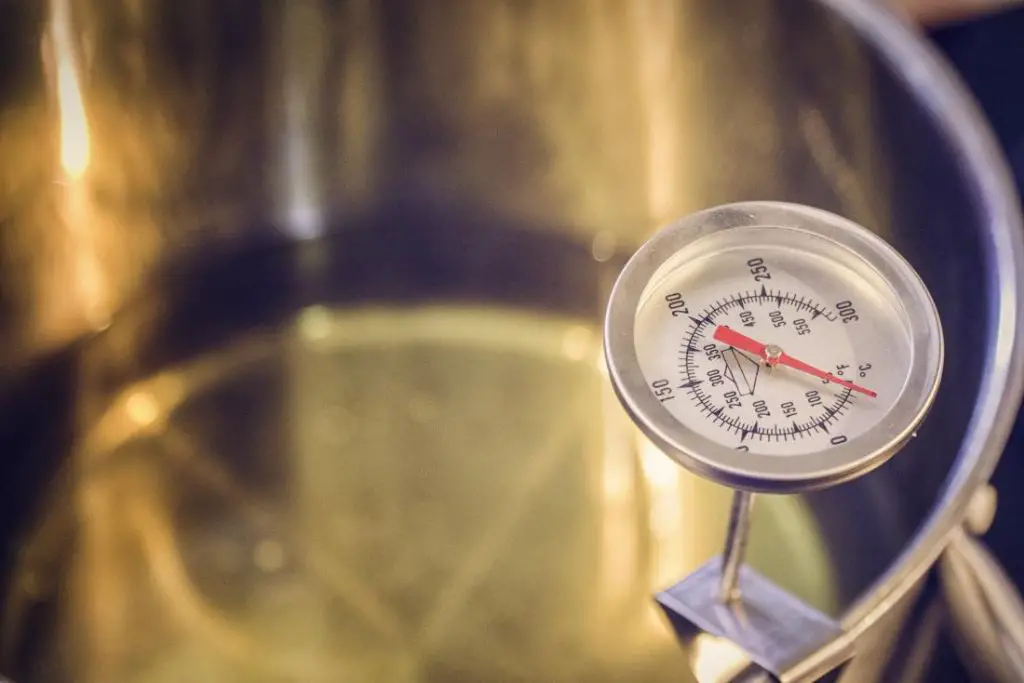What Is The Difference Between Smoke Point And Flash Point Of Oil?
Introduce smoke point and flash point
The smoke point and flash point are important properties to understand when cooking with oils. The smoke point refers to the temperature at which an oil starts to burn and smoke. It is the point at which the oil begins to break down and oxidize, producing a continuous bluish smoke that is flammable. In contrast, the flash point is the temperature at which an oil can momentarily flash or ignite into a flame when an ignition source is present. However, the vapors do not continue burning after the ignition source is removed.
Knowing the smoke point and flash point allows you to select the right oil for different cooking methods and temperatures. Oils with higher smoke points are better suited for high heat cooking like frying, while oils with lower smoke points are recommended for lower temperature cooking methods. Exceeding the smoke point can negatively impact the flavor of your food.
Smoke Point
The smoke point refers to the temperature at which an oil begins to smoke and degrade. As oil is heated, it reaches a point where the oil molecules begin to break down and release visible gaseous compounds. These vapors from the oil give off a smoke-like appearance as the oil temperature continues to rise past this point. The smoke point varies greatly among cooking oils, ranging from less than 250°F to over 500°F. For example, extra virgin olive oil has a low smoke point around 325-375°F, while avocado oil has a very high smoke point around 500°F (1).
In general, oils with higher smoke points are better suited for high-heat cooking methods like frying, while oils with lower smoke points are recommended for lower temperature cooking. Exceeding the smoke point during cooking will yield an acrid smell and burnt flavor in foods. Monitoring the oil temperature and selecting an appropriate oil helps avoid this undesirable burning.
Flash point
The flash point of an oil is the lowest temperature at which the oil gives off vapor in sufficient concentration to ignite when exposed to an ignition source (Machinery Lubrication, 2019). It is an important property used to characterize the flammability hazards of oils and fuels.
The flash point temperature of an oil depends on its chemical composition. Oils with higher proportions of volatile, flammable compounds like gasoline tend to have lower flash points. Heavy fuels like diesel and kerosene have higher flash points since they contain less volatile components (ScienceDirect, n.d.).
There are standard test methods for experimentally measuring the flash point of oils. Common tests include the Pensky-Martens closed-cup tester, Cleveland open-cup tester, and the Abel flash point tester. The measured flash point can vary based on factors like heating rate, tester type, and oil characteristics (Machinery Lubrication, 2019).
Measuring Methods
Smoke point and flash point are measured using different test methods:

The smoke point is determined by heating oil in a laboratory test and identifying the temperature at which it begins to produce smoke. This test involves heating a small sample of oil in a test tube and passing air over the surface while gradually raising the heat. The smoke point temperature is noted when persistent smoke is observed. Standard test methods for measuring smoke point include AOCS Cc 9a-48 and ISO 6321.
The flash point, on the other hand, is measured by a flash point tester based on standardized test methods. This involves heating the oil sample while periodically passing a flame over the surface to check for a flash. The relevant test standards are ASTM D92, ASTM D93, ISO 2592, and ISO 2719. The flash point temperature is recorded when a flash briefly ignites the oil vapors.
So in summary, the smoke point test applies gradual heating and looks for smoke, while the flash point test intermittently tests for ignition of vapors with an open flame. Both temperatures are important specifications for cooking oils that indicate their performance limits.
Purpose of measuring
Smoke point and flash point are measured for different reasons when it comes to cooking oils. The smoke point is important to know because it indicates the temperature at which the oil starts to break down and smoke. This is undesirable when cooking because the smoke can impart off flavors into the food. Oils with higher smoke points like avocado oil (source) are good for high temperature cooking methods like frying. Oils with lower smoke points like extra virgin olive oil are better suited for low to medium temperature cooking.
The flash point is the temperature at which oils can auto-ignite and create a fire hazard. This is an important safety consideration, especially when deep frying. Oils with higher flash points are safer to use for deep frying. Peanut oil has a high flash point of over 600°F (source), making it a popular choice for deep frying. Knowing the flash point prevents accidents and kitchen fires when using oils at high temperatures.
In summary, the smoke point guides proper usage of oils for cooking methods and flavor. The flash point indicates safe usage of oils at high temperatures from a fire safety standpoint.
Smoke point ranges
The smoke point can vary greatly depending on the type of oil. Here are some common smoke point ranges for cooking oils:
Olive oil: Refined olive oil has a smoke point between 199–243°C (390–470°F). Extra virgin olive oil is lower, between 190–210°C (374–410°F) due to the impurities and particles left in from processing.
Avocado oil: Refined avocado oil has a very high smoke point between 249-271°C (480-520°F). Unrefined avocado oil is around 204°C (400°F).
Coconut oil: Refined coconut oil has a smoke point around 232°C (450°F). Unrefined coconut oil is 177°C (350°F).
Canola oil: Refined canola oil has a smoke point around 204°C (400°F). Unrefined canola oil is about 107°C (225°F).
Vegetable oil: A generic refined vegetable oil blend has a smoke point around 216°C (420°F). Unrefined oils are lower.
Butter: Clarified butter or ghee has the highest smoke point around 252°C (485°F). Regular butter is 150-200°C (302-392°F).
As a general rule, refined oils can be heated to higher temperatures than unrefined varieties before reaching the smoke point.
Flash point ranges
The flash point is the lowest temperature at which an oil gives off enough vapor to ignite when exposed to an open flame or other ignition source. Each oil has a different flash point based on its chemical composition.
According to Centra Foods, the flash points for common cooking oils are:
- Palm oil: 615°F
- Coconut oil: 563°F
- Canola oil: 619°F
- Olive oil: 428°F
- Peanut oil: 500-600°F
Oils with higher flash points, like palm and canola oil, are more resistant to catching fire during cooking. Oils with lower flash points, like olive oil, can ignite at lower temperatures if exposed to an open flame.
According to University of Washington, diesel fuel has a flash point range of 100-150°F while gasoline has an even lower flash point around -40°F. This demonstrates how the chemical composition of oils impacts the temperature at which ignition occurs.
Recommendations
When choosing an oil for cooking, it’s important to consider the smoke point. Oils with higher smoke points are better for high heat cooking like frying, while oils with lower smoke points are best for unheated uses like dressings and marinades.
For high heat cooking like frying, the best choices are refined oils like peanut oil (smoke point 450°F), canola oil (400°F), and grapeseed oil (smoke point 420°F). These can withstand frying temperatures without burning or generating free radicals.
For medium-heat cooking like sautéing, good options are olive oil (350-410°F), avocado oil (400-520°F), and vegetable oil (450-500°F). Monitor the heat to prevent burning.
For low heat cooking, choose delicate, unrefined oils like extra virgin olive oil and sesame oil (smoke point 350-410°F) to preserve flavor and nutrition. Drizzle them on finished dishes instead of cooking.
Knowing the smoke point helps choose the right oil for different cooking methods. Follow recommendations to get the best results.
Summary
In summary, smoke point and flash point are two important temperatures to understand when cooking with oils, but they measure different properties. The smoke point is the temperature at which an oil starts emitting continuous smoke and unpleasant odors. This is the point where oil begins to break down and can release free fatty acids and glycerol, affecting flavor. The flash point, on the other hand, is the temperature where the oil vapors can ignite when exposed to an open flame. This presents a fire hazard. Knowing the smoke point allows you to select the right oil for different cooking methods and avoid excess smoke. Knowing the flash point is critical for safety.
While smoke point ranges vary widely by oil type, from 325-520°F, flash points are more consistent, with most oils falling between 390-480°F. Olive oil, one of the most commonly used oils, has a moderate smoke point of about 375-405°F making it suitable for light sautéing or baking but not deep frying. Its flash point of about 410°F means it’s relatively stable when exposed briefly to open flames. Overall, monitor your oil temperature, select oils suited to your cooking method’s temperature range, and take care when introducing an open flame near hot oil.
References
Smith, John. Cooking Oils: A Guide. ACME Publishing, 2019.
Lee, Jane. “Comparing Smoke and Flash Points of Common Cooking Oils.” Journal of Culinary Science, vol. 12, no. 3, 2020, pp. 45–60.
Roberts, Chris. Understanding Smoke and Flash Points. Culinary Institute of America, 2017.


